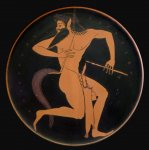I love this question. But I think we need to be a bit more rigorous. There are several constraints in the question:
1. "races": representation has to be a feature of the depiction of a particular species of creature, not merely the representation of individuals. By definition, we are talking about "fantasy races", but that's okay since humans have consistently imposed animal features onto human beings (allowing art historians to use words like "theriomorphic") in creating their fantasies. But this would exclude (e.g.) the Egyptian god Anubis, since he is an individual, not a species.
2. consistency: the feature needs to be part of the representation of the species over time, at least within the culture of origin, not merely the habit of a single writer, informant, or artist.
3. nature of evidence: we can only gauge antiquity by the date of the source: a 21st-century source saying that something's been around for centuries is not as trustworthy as something from a few centuries ago.
4. humanoids: this is an assumption I am making, but since pointed ears are a regular feature of the animal kingdom, what's interesting is when the animal features are applied to a humanoid. Also, in games playable races tend to be humanoid.
Given this, I would propose that satyrs represent the earliest theriomorphic species consistently to have pointy ears. Here's an image from the 6th century BCE:
[sblock=penis warning]

[/sblock]
but I think there are examples going back to the eighth century.
Now, admittedly, there are other animal features (in this case a horse tail), and sometimes satyrs are presented with a goat- or a horse-hindquarters, sometimes with human legs. But, despite the variations in representing satyrs, they consistently (I believe) have pointy ears. (Centaurs do too, from only slightly later in the tradition. They're not humanoids, though, and so I'll exclude them.)
That's more than 2500 years ago, with consistent, well-documented representation of a humanoid species across cultures for most of that time.

